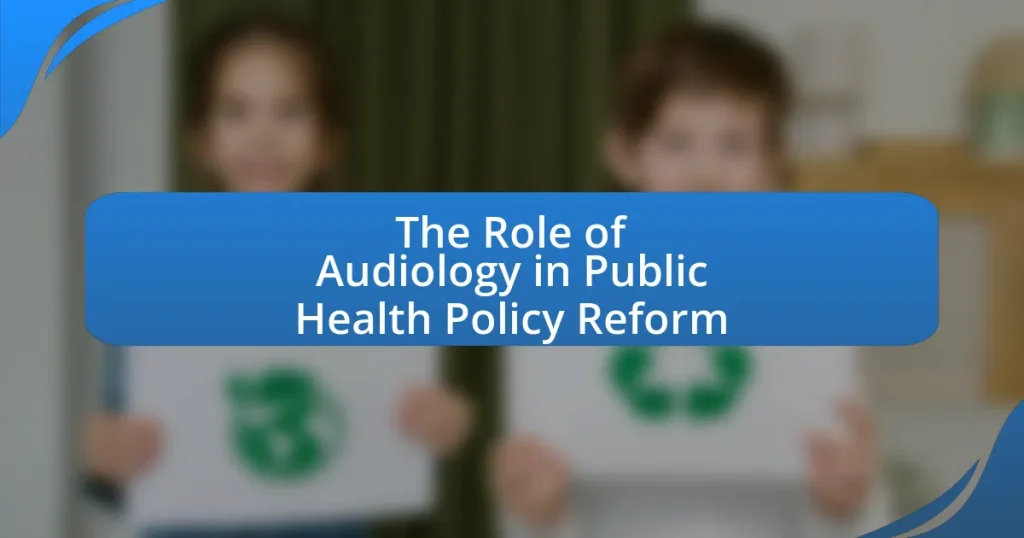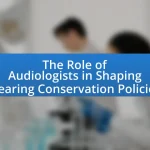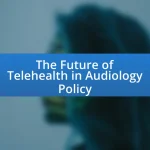Audiology is a vital component of public health policy reform, focusing on the prevention, identification, and management of hearing loss, which affects approximately 466 million people globally. The article outlines how audiology influences public health outcomes through early detection and intervention, addressing key areas such as hearing loss prevention and communication accessibility. It highlights the importance of integrating audiology services into public health initiatives to improve health outcomes and reduce healthcare costs associated with untreated hearing loss. Additionally, the article discusses the challenges audiology professionals face in policy reform, the role of public awareness, and strategies for effective advocacy to enhance access to hearing healthcare services.
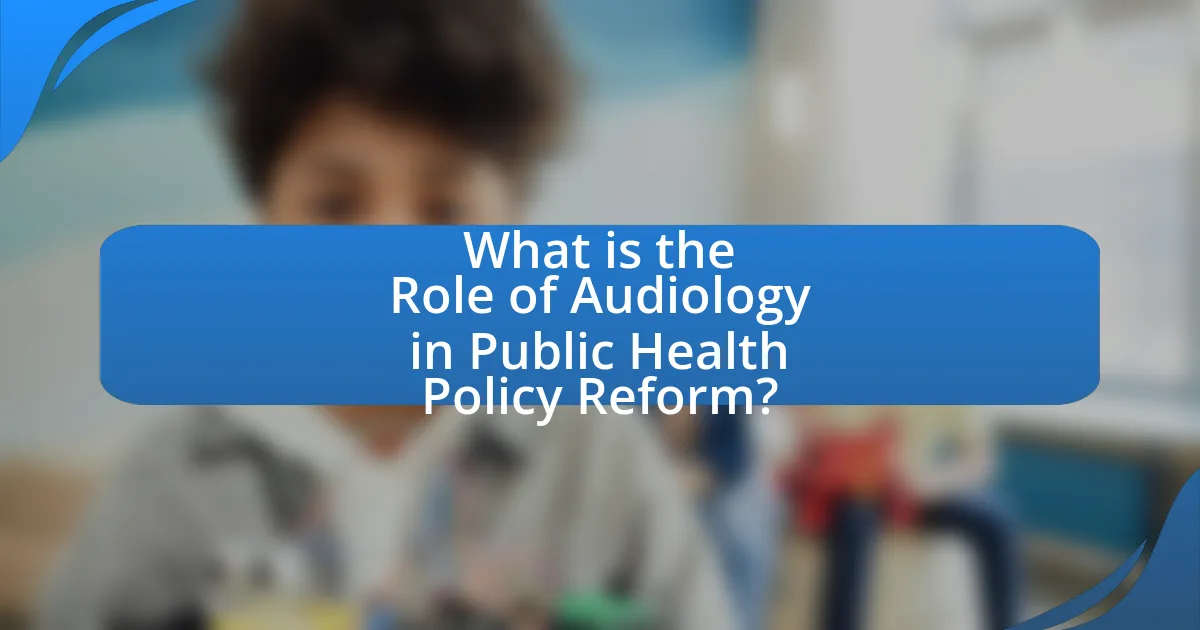
What is the Role of Audiology in Public Health Policy Reform?
Audiology plays a crucial role in public health policy reform by advocating for the prevention, identification, and management of hearing loss and related disorders. This field contributes to policy development by providing evidence-based research that highlights the prevalence of hearing impairment, which affects approximately 466 million people globally, according to the World Health Organization. Audiologists inform policymakers about the economic and social impacts of untreated hearing loss, including increased healthcare costs and reduced quality of life. By collaborating with public health officials, audiologists help shape initiatives that promote early screening, access to hearing healthcare services, and educational programs aimed at raising awareness about hearing health.
How does audiology influence public health outcomes?
Audiology significantly influences public health outcomes by improving early detection and management of hearing loss, which is crucial for effective communication and overall quality of life. Research indicates that untreated hearing loss can lead to increased social isolation, depression, and cognitive decline, impacting both individual health and healthcare costs. For instance, a study published in the Journal of the American Geriatrics Society found that older adults with untreated hearing loss had a 50% higher risk of cognitive decline compared to those with normal hearing. By integrating audiology services into public health initiatives, communities can enhance access to hearing screenings and interventions, ultimately reducing the burden of hearing-related issues on public health systems.
What are the key areas where audiology impacts public health?
Audiology impacts public health primarily in three key areas: hearing loss prevention, early detection and intervention, and the promotion of communication accessibility. Hearing loss prevention initiatives, such as public awareness campaigns about noise-induced hearing loss, significantly reduce the incidence of auditory impairments. Early detection and intervention programs, including newborn hearing screenings, are crucial as they facilitate timely treatment, which can improve developmental outcomes for children. Additionally, promoting communication accessibility through legislation and policy reform, such as the Americans with Disabilities Act, ensures that individuals with hearing impairments can access essential services, thereby enhancing their quality of life and participation in society. These areas collectively contribute to improved public health outcomes by addressing the social and economic impacts of hearing loss.
How does hearing health relate to overall public health initiatives?
Hearing health is integral to overall public health initiatives as it directly impacts quality of life, communication, and social integration. Poor hearing health can lead to increased healthcare costs, reduced productivity, and social isolation, which are significant public health concerns. According to the World Health Organization, unaddressed hearing loss affects over 1.5 billion people globally, highlighting the need for public health strategies that include hearing health as a priority. Effective public health initiatives that incorporate audiology can improve early detection and intervention, ultimately enhancing population health outcomes and reducing the burden on healthcare systems.
Why is audiology important in shaping health policies?
Audiology is important in shaping health policies because it addresses the prevention, diagnosis, and management of hearing loss, which affects approximately 466 million people worldwide. Effective health policies informed by audiology can lead to improved access to hearing healthcare services, thereby enhancing quality of life and reducing the economic burden associated with untreated hearing loss, which is estimated to cost the global economy $750 billion annually. By integrating audiological expertise into public health initiatives, policymakers can ensure that hearing health is prioritized, ultimately leading to better health outcomes and increased awareness of auditory health issues.
What evidence supports the inclusion of audiology in public health policy?
Evidence supporting the inclusion of audiology in public health policy includes the significant prevalence of hearing loss, which affects approximately 466 million people globally, according to the World Health Organization. This statistic underscores the need for systematic audiological services to address early detection and intervention. Furthermore, research indicates that untreated hearing loss can lead to increased healthcare costs, social isolation, and cognitive decline, as highlighted in a study published in the Journal of the American Geriatrics Society, which found that individuals with untreated hearing loss had a 50% higher risk of cognitive decline. These findings demonstrate that integrating audiology into public health policy can improve health outcomes and reduce long-term costs associated with untreated hearing conditions.
How can audiology address health disparities in communities?
Audiology can address health disparities in communities by increasing access to hearing healthcare services and promoting awareness of hearing health issues. By implementing community outreach programs, audiologists can provide screenings and education in underserved areas, which is essential since approximately 48 million Americans experience hearing loss, yet many do not receive the necessary care due to socioeconomic barriers. Research indicates that early identification and intervention can significantly improve quality of life and communication outcomes, thereby reducing disparities. Furthermore, audiologists can advocate for policy reforms that ensure equitable access to hearing aids and rehabilitation services, addressing systemic inequalities in healthcare access.
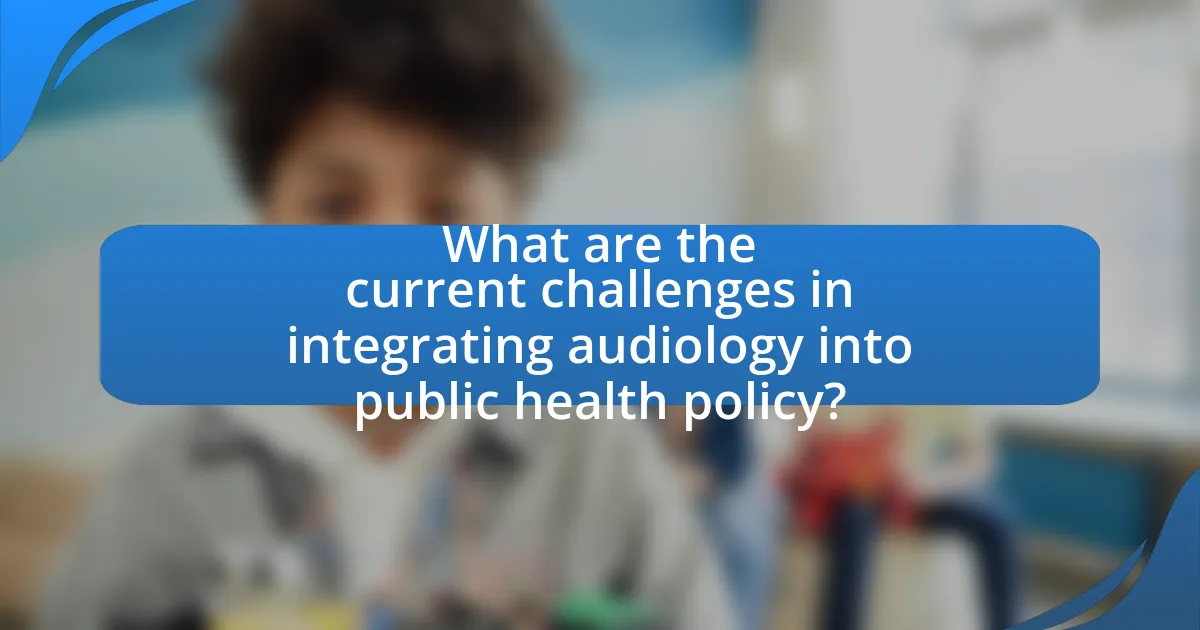
What are the current challenges in integrating audiology into public health policy?
The current challenges in integrating audiology into public health policy include a lack of awareness among policymakers, insufficient funding for audiology services, and the need for standardized protocols. Policymakers often overlook the significance of hearing health, which leads to inadequate representation of audiology in health agendas. Additionally, funding for audiology programs is frequently limited, hindering the development and implementation of necessary services. Standardization of audiology practices is also essential, as inconsistent protocols can create disparities in care and access. These challenges are supported by research indicating that hearing loss affects approximately 466 million people globally, yet many health systems do not prioritize audiology, resulting in a gap in public health initiatives.
What barriers exist for audiology professionals in policy reform?
Audiology professionals face several barriers in policy reform, including limited awareness of audiology issues among policymakers, insufficient funding for research and advocacy, and a lack of unified professional representation. Policymakers often prioritize more visible health issues, leading to neglect of audiology-related concerns. Additionally, the field struggles with inadequate financial resources, which hampers efforts to conduct research that could inform policy changes. Furthermore, the absence of a cohesive voice among audiology organizations can dilute advocacy efforts, making it challenging to influence legislative agendas effectively.
How do funding and resource allocation affect audiology services?
Funding and resource allocation significantly impact audiology services by determining the availability and quality of care provided to patients. Adequate funding allows for the hiring of qualified audiologists, the purchase of advanced diagnostic equipment, and the implementation of comprehensive treatment programs. For instance, a study published in the Journal of the American Academy of Audiology found that increased funding in public health initiatives led to improved access to hearing screenings and interventions, resulting in better health outcomes for individuals with hearing loss. Conversely, insufficient funding can lead to understaffed clinics, outdated technology, and limited patient outreach, ultimately compromising the effectiveness of audiology services.
What role does public awareness play in overcoming these challenges?
Public awareness is crucial in overcoming challenges related to audiology and public health policy reform. Increased public awareness leads to better understanding and recognition of hearing health issues, which can drive demand for services and influence policy changes. For instance, campaigns that educate the public about the importance of early hearing detection have been shown to increase screening rates, as evidenced by the Centers for Disease Control and Prevention reporting a rise in newborn hearing screenings from 50% in 2000 to over 95% in 2019 due to awareness initiatives. This heightened awareness not only encourages individuals to seek help but also pressures policymakers to allocate resources and implement reforms that address audiological needs effectively.
How can audiology advocates influence policy change?
Audiology advocates can influence policy change by actively engaging in legislative processes, raising awareness about hearing health issues, and collaborating with stakeholders. These advocates often participate in lobbying efforts to promote policies that support access to audiological services and funding for hearing health initiatives. For instance, the American Speech-Language-Hearing Association (ASHA) has successfully advocated for the inclusion of audiology services in Medicare, demonstrating the impact of organized advocacy on policy outcomes. Additionally, research shows that public awareness campaigns led by audiology professionals can significantly increase support for policies aimed at improving hearing health access, thereby reinforcing the importance of advocacy in shaping effective public health policies.
What strategies can audiologists use to engage policymakers?
Audiologists can engage policymakers by utilizing evidence-based advocacy, building coalitions, and leveraging data to highlight the importance of hearing health. Evidence-based advocacy involves presenting research that demonstrates the impact of hearing loss on public health, such as the World Health Organization’s report indicating that unaddressed hearing loss costs the global economy $750 billion annually. Building coalitions with other health professionals and organizations can amplify their voice and create a unified front for policy change. Additionally, audiologists can use data from studies, like those published in the Journal of the American Academy of Audiology, to inform policymakers about the benefits of early intervention and access to hearing care services, thereby influencing legislative priorities.
How can collaboration with other health professionals enhance advocacy efforts?
Collaboration with other health professionals enhances advocacy efforts by creating a unified voice that amplifies the message and increases credibility. When audiologists partner with physicians, nurses, and public health experts, they can share diverse perspectives and expertise, leading to more comprehensive advocacy strategies. For instance, a study published in the Journal of Public Health Management and Practice found that interdisciplinary collaboration in health advocacy initiatives resulted in improved health outcomes and policy changes, demonstrating the effectiveness of combined efforts. This collective approach not only strengthens the advocacy message but also fosters a more holistic understanding of public health issues, ultimately leading to more impactful reforms in areas such as audiology and hearing health policy.
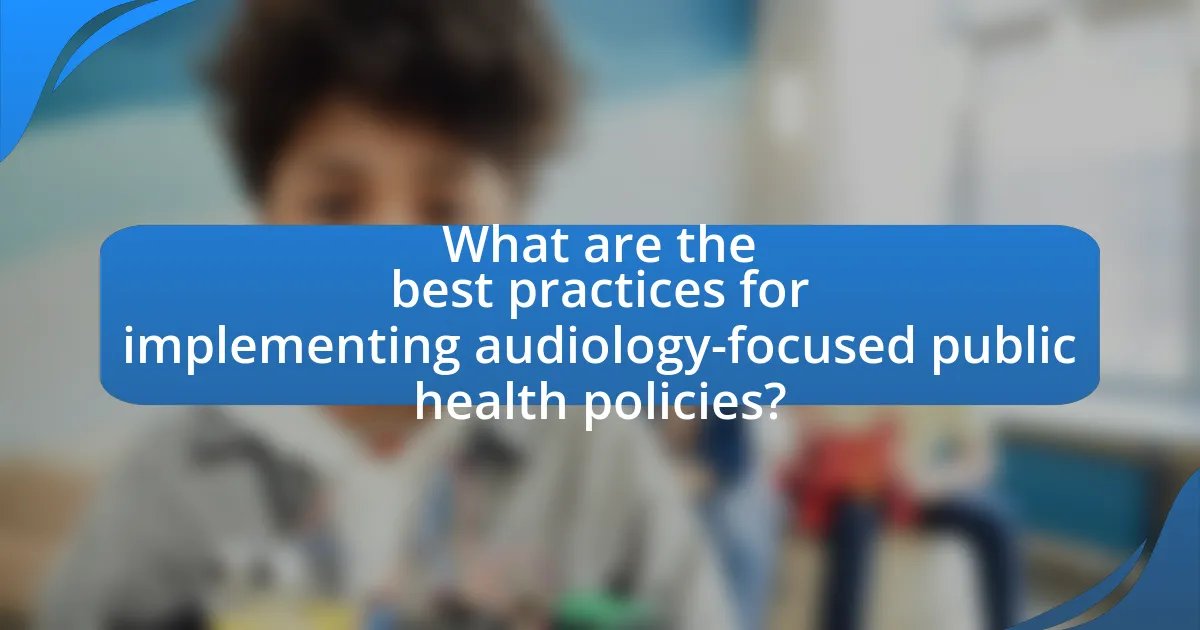
What are the best practices for implementing audiology-focused public health policies?
The best practices for implementing audiology-focused public health policies include establishing comprehensive screening programs, integrating audiology services into primary healthcare, and promoting public awareness campaigns about hearing health. Comprehensive screening programs, such as newborn hearing screening, have been shown to significantly improve early detection and intervention rates, leading to better long-term outcomes for individuals with hearing loss. Integrating audiology services into primary healthcare ensures that hearing health is addressed alongside other health issues, facilitating a holistic approach to patient care. Public awareness campaigns can educate communities about the importance of hearing health, encouraging individuals to seek timely evaluation and treatment, which is crucial given that untreated hearing loss can lead to social isolation and cognitive decline. These practices are supported by evidence from various public health initiatives that demonstrate their effectiveness in improving hearing health outcomes.
How can data and research inform policy decisions in audiology?
Data and research can inform policy decisions in audiology by providing evidence-based insights that guide the development and implementation of effective hearing health initiatives. For instance, studies such as the “Global Burden of Disease Study” highlight the prevalence and impact of hearing loss, which can drive policymakers to allocate resources for prevention and treatment programs. Additionally, research findings on the efficacy of early intervention strategies, like those published in the “Journal of the American Academy of Audiology,” demonstrate how timely audiological care can improve outcomes, thereby influencing policy frameworks to prioritize such interventions. By utilizing comprehensive data, policymakers can make informed decisions that enhance public health strategies related to audiology.
What types of data are most effective in advocating for audiology services?
Quantitative data, such as prevalence rates of hearing loss and economic impact studies, are most effective in advocating for audiology services. For instance, the World Health Organization reports that over 1.5 billion people globally experience hearing loss, highlighting the widespread need for audiology services. Additionally, economic analyses demonstrate that untreated hearing loss can lead to increased healthcare costs and reduced productivity, with estimates suggesting that the economic burden of hearing loss in the U.S. alone exceeds $100 billion annually. These statistics provide compelling evidence for the necessity of audiology services in public health policy reform.
How can successful case studies be utilized in policy reform?
Successful case studies can be utilized in policy reform by providing evidence-based examples that demonstrate the effectiveness of specific interventions or strategies. These case studies serve as models for policymakers, illustrating successful outcomes and best practices that can be replicated in similar contexts. For instance, a case study highlighting a community-based hearing screening program that significantly improved early detection rates of hearing loss can inform the development of national screening policies. By presenting quantitative data, such as a 30% increase in early diagnoses, these case studies validate the need for policy changes and guide resource allocation. Furthermore, successful case studies can engage stakeholders by showcasing real-world impacts, thereby fostering support for proposed reforms.
What practical steps can audiologists take to promote policy reform?
Audiologists can promote policy reform by actively engaging in advocacy efforts, collaborating with professional organizations, and participating in public health initiatives. Advocacy efforts include educating policymakers about the importance of hearing health and the impact of untreated hearing loss on public health, which can be supported by statistics indicating that untreated hearing loss affects approximately 48 million Americans. Collaborating with organizations such as the American Academy of Audiology allows audiologists to leverage collective resources and expertise to influence policy changes. Additionally, participating in public health initiatives, such as community screenings and awareness campaigns, helps raise awareness and demonstrates the need for policy reform in hearing health services.
How can audiologists build coalitions with other health sectors?
Audiologists can build coalitions with other health sectors by actively engaging in interdisciplinary collaborations and establishing communication channels with professionals in related fields such as primary care, speech-language pathology, and public health. These collaborations can be facilitated through joint workshops, conferences, and community outreach programs that emphasize the importance of hearing health in overall wellness. Research indicates that integrated care models, which include audiologists, lead to improved patient outcomes and more comprehensive health services, as evidenced by studies showing that patients receiving coordinated care experience better management of comorbid conditions. By leveraging these partnerships, audiologists can advocate for policies that address hearing health as a critical component of public health initiatives.
What role does community engagement play in policy advocacy?
Community engagement is crucial in policy advocacy as it fosters collaboration between stakeholders and amplifies the voices of those affected by policies. Engaging the community ensures that policy decisions reflect the needs and priorities of the population, leading to more effective and equitable outcomes. Research indicates that policies developed with community input are more likely to gain public support and achieve successful implementation, as seen in various public health initiatives where community feedback directly influenced policy changes. For instance, the Centers for Disease Control and Prevention (CDC) emphasizes the importance of community engagement in health policy to enhance program effectiveness and sustainability.
What resources are available for audiologists seeking to influence public health policy?
Audiologists seeking to influence public health policy can access several key resources, including professional organizations, advocacy groups, and research publications. Organizations such as the American Academy of Audiology and the American Speech-Language-Hearing Association provide guidelines, toolkits, and networking opportunities that empower audiologists to engage in policy discussions. Additionally, advocacy groups like the Hearing Loss Association of America offer platforms for audiologists to participate in legislative advocacy and public awareness campaigns. Research publications in journals such as the Journal of the American Academy of Audiology provide evidence-based data that can support policy initiatives aimed at improving hearing health services. These resources collectively equip audiologists with the knowledge and tools necessary to effectively influence public health policy.
What organizations support audiology advocacy efforts?
Several organizations support audiology advocacy efforts, including the American Speech-Language-Hearing Association (ASHA), the American Academy of Audiology (AAA), and the Academy of Doctors of Audiology (ADA). These organizations actively engage in policy advocacy to promote the interests of audiologists and improve access to audiological services. For instance, ASHA has a dedicated advocacy team that works on legislative issues affecting speech and hearing services, while AAA focuses on advancing the profession through education and public policy initiatives. The ADA also emphasizes the importance of legislative advocacy to enhance the practice of audiology and ensure quality care for patients.
How can audiologists access training and tools for effective policy engagement?
Audiologists can access training and tools for effective policy engagement through professional organizations, online courses, and workshops specifically designed for healthcare advocacy. Organizations such as the American Academy of Audiology and the American Speech-Language-Hearing Association offer resources, including webinars and training sessions, that focus on policy advocacy skills. Additionally, platforms like Coursera and LinkedIn Learning provide courses on health policy and advocacy that can enhance audiologists’ understanding and effectiveness in engaging with public health policy. These resources are validated by the increasing emphasis on interprofessional collaboration in healthcare, which highlights the need for audiologists to be equipped with policy engagement skills to influence public health reforms effectively.
